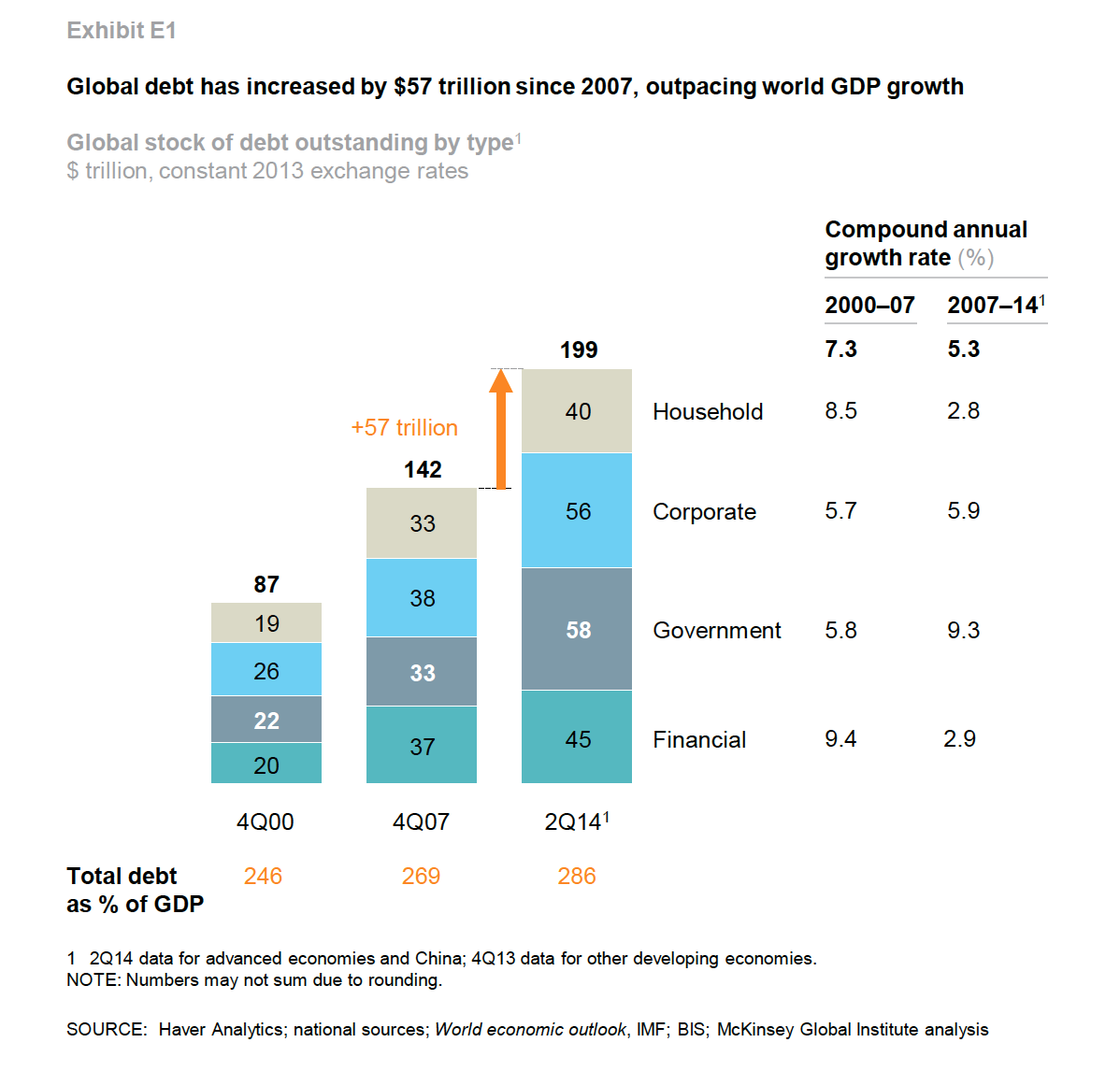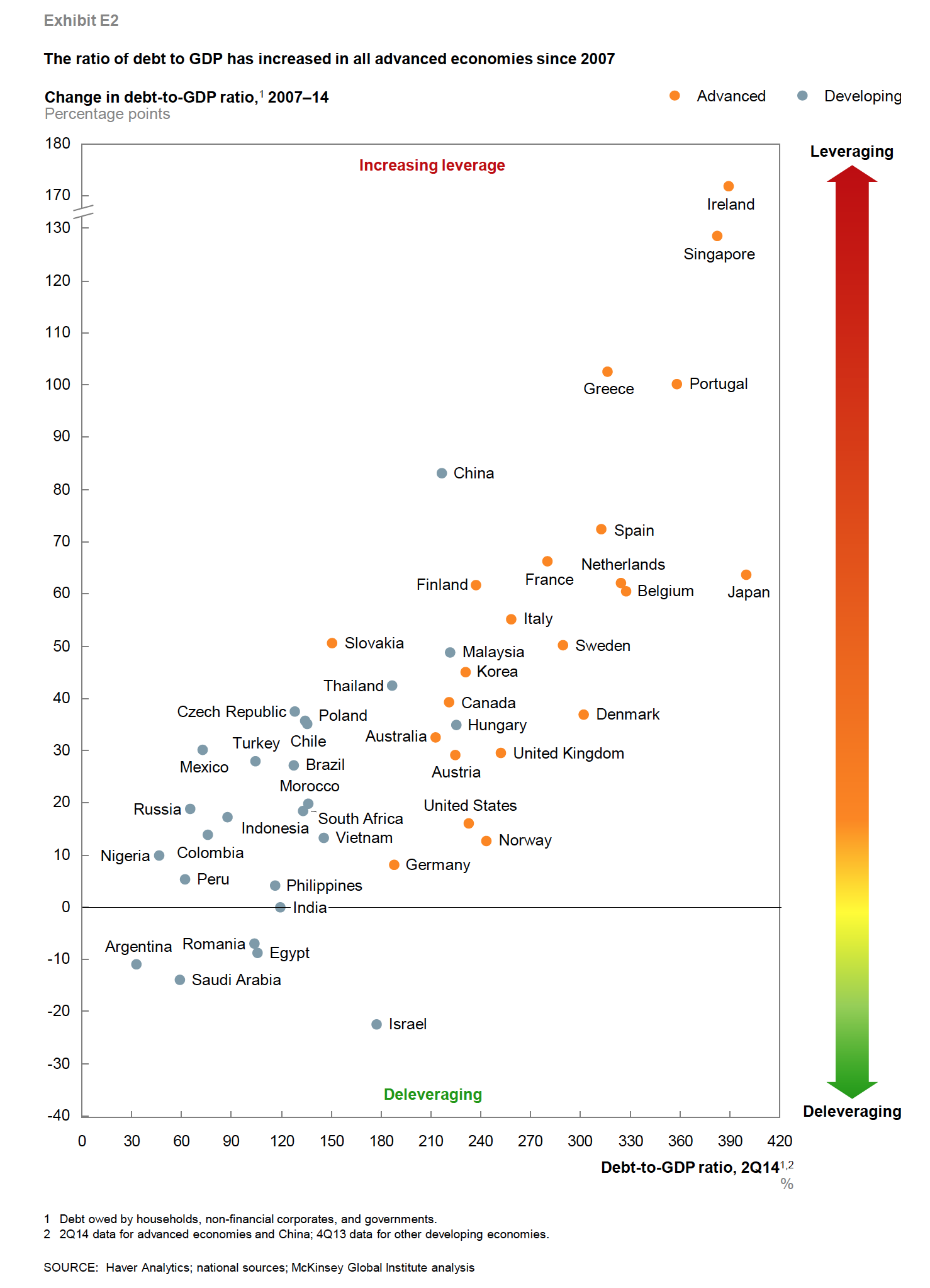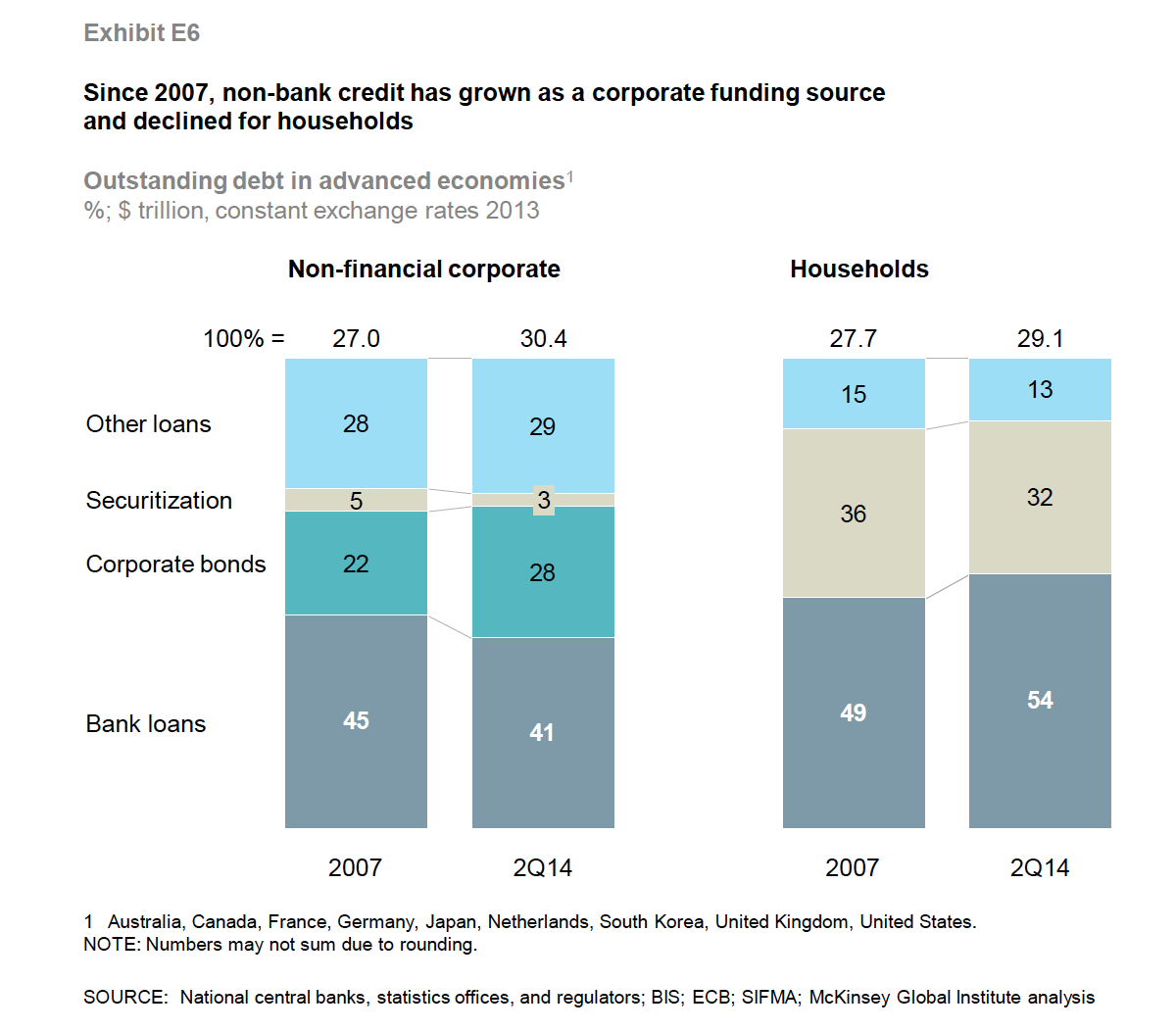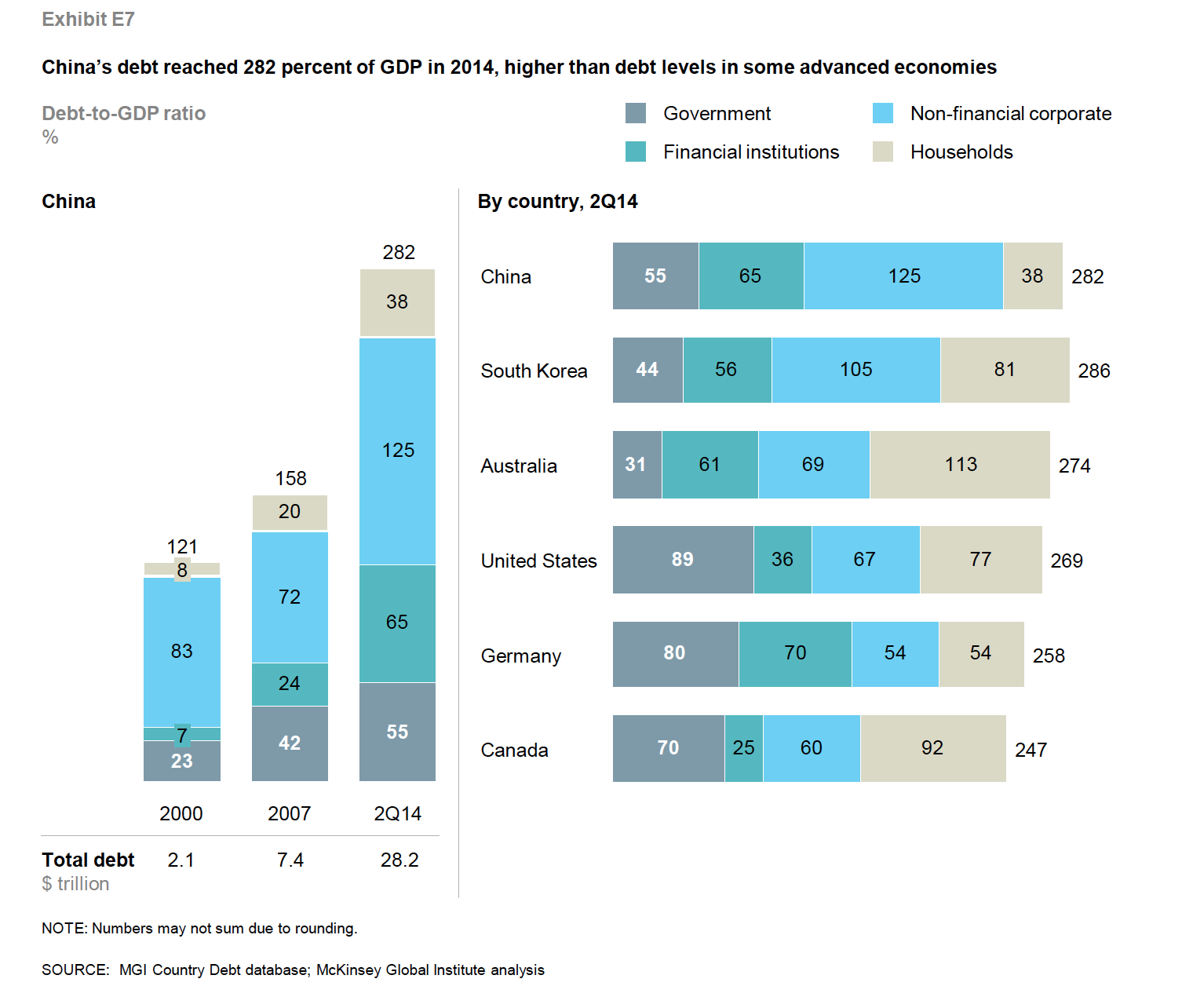Seven Years Later, Global Debt Keeps Piling Up, $57 Trillion More Than 2007
Seven years after the bursting of a global credit bubble resulted in the worst financial crisis since the Great Depression, debt continues to grow. In fact, as McKinsey explains in their latest report, rather than reducing indebtedness, or deleveraging, all major economies today have higher levels of borrowing relative to GDP than they did in 2007.
Government debt is unsustainably high in some countries - Debt is too high for either austerity or growth to cure !
As Mike Shedlock wrote:
Central bankers still have not figured out the absurdity of their efforts to cure deflation via low interest rates. By forcing down interest rates and encouraging more lending, debts of all sorts keep piling up with no realistic way of paying those debts off.
McKinsey Global Institute
Originally posted on Feb, 2015
Debt and (not much) deleveraging
Seven years after the bursting of a global credit bubble resulted in the worst financial crisis since the Great Depression, debt continues to grow. In fact, rather than reducing indebtedness, or deleveraging, all major economies today have higher levels of borrowing relative to GDP than they did in 2007. Global debt in these years has grown by $57 trillion, raising the ratio of debt to GDP by 17 percentage points. That poses new risks to financial stability and may undermine global economic growth.

Government Debt
Government debt is unsustainably high in some countries. Since 2007, government debt has grown by $25 trillion. It will continue to rise in many countries, given current economic fundamentals. Some of this debt, incurred with the encouragement of world leaders to finance bailouts and stimulus programs, stems from the crisis. Debt also rose as a result of the recession and the weak recovery. For six of the most highly indebted countries, starting the process of deleveraging would require implausibly large increases in real-GDP growth or extremely deep fiscal adjustments.

Household Debt
Household debt is reaching new peaks. Only in the core crisis countries—Ireland, Spain, the United Kingdom, and the United States—have households deleveraged. In many others, household debt-to-income ratios have continued to rise. They exceed the peak levels in the crisis countries before 2008 in some cases, including such advanced economies as Australia, Canada, Denmark, Sweden, and the Netherlands, as well as Malaysia, South Korea, and Thailand. These countries want to avoid property-related debt crises like those of 2008.

China
China’s debt has quadrupled since 2007. Fueled by real estate and shadow banking, China’s total debt has nearly quadrupled, rising to $28 trillion by mid-2014, from $7 trillion in 2007. At 282 percent of GDP, China’s debt as a share of GDP, while manageable, is larger than that of the United States or Germany. Three developments are potentially worrisome: half of all loans are linked, directly or indirectly, to China’s overheated real-estate market; unregulated shadow banking accounts for nearly half of new lending; and the debt of many local governments is probably unsustainable. However, MGI calculates that China’s government has the capacity to bail out the financial sector should a property-related debt crisis develop. The challenge will be to contain future debt increases and reduce the risks of such a crisis, without putting the brakes on economic growth.
The rapid growth of shadow banking in China is a second area of concern: loans by shadow banking entities total $6.5 trillion and account for 30 percent of China’s outstanding debt (excluding the financial sector) and half of new lending. Most of the loans are for the property sector. The main vehicles in shadow banking include trust accounts, which promise wealthy investors high returns; wealth management products marketed to retail customers; entrusted loans made by companies to one another; and an array of financing companies, microcredit institutions, and informal lenders. Both trust accounts and wealth management products are often marketed by banks, creating a false impression that they are guaranteed. The underwriting standards and risk management employed by managers of these funds are also unclear. Entrusted loans involve lending between companies, creating the potential for a ripple of defaults in the event that one company fails. The level of risk of shadow banking in China could soon be tested by the slowdown in the property sector.

What Happened to Deleveraging?
Growing government debt has offset private-sector deleveraging in advanced economies Rising government debt (debt of central and local governments, not state-owned enterprises) has been a significant cause of rising global debt since 2007. Government debt grew by $25 trillion between 2007 and mid-2014, with $19 trillion of that in advanced economies. To be sure, the growth in government spending and debt during the depths of the recession was a welcome policy response. At their first meeting in Washington in November 2008, the G20 nations collectively urged policy makers to use fiscal stimulus to boost growth.
Not surprisingly, the rise in government debt, as a share of GDP, has been steepest in countries that faced the most severe recessions: Ireland, Spain, Portugal, and the United Kingdom. The challenge for these countries now is to find ways to reduce very high levels of debt.
Given current primary fiscal balances, interest rates, inflation, and projected real GDP
growth rates over the next five years, we calculate that the ratio of government debt to GDP will continue to grow in many advanced economies, including Japan, the United States, the United Kingdom, and a range of European countries.
Mortgage Debt
Real estate and land prices are the major drivers of household debt over time What is causing the continuous rise of household debt around the world? Rising mortgage debt is the main cause, as documented in research by Jordà et al.36 In the United States, for example, household debt grew from just 16 percent of disposable income in 1945 to 125 percent at the peak in 2007, with mortgage debt accounting for 78 percent of the growth (Exhibit 15). Mortgage debt represents the majority of household debt growth in other countries as well. Our data show that mortgages now account for 74 percent of household debt in advanced economies and 43 percent of household debt in developing economies (where household loans also include borrowing for small family businesses).
Revisit Tax Incentives for Debt
Because real estate and credit bubbles helped trigger the 2008 financial crisis and many previous crises, policy makers should reconsider the tax preferences given for household mortgages. The incentives that governments give for real estate vary widely across countries, but include deductibility of mortgage interest expenses and preferential capital gains treatment on residential home sales.
While these incentives are usually adopted to promote the social goal of homeownership, in practice they provide the greatest benefits for high-income households that pay the highest taxes. Moreover, they help create housing bubbles by encouraging households to take on larger mortgages to buy more expensive homes.
Policymakers therefore may need to revisit the mix of incentives given for homeownership and balance this goal against public incentives for other investments – particularly those that expand the long-term productive capacity of the economy, which residential real estate in most cases does not.








